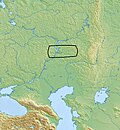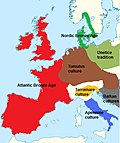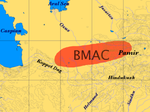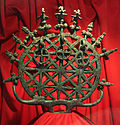The Abashevo culture (Russian: Абашевская культура, romanized: Abashevskaya kul'tura) is a late Middle Bronze Age archaeological culture, ca. 2200–1850...
25 KB (2,936 words) - 17:15, 15 April 2024
later cultures that are identified as Indo-Iranian. The Poltavka culture influenced the later emergence of the Potapovka culture, Abashevo culture, Sintashta...
17 KB (2,144 words) - 12:39, 9 February 2024
findings that the Sintashta culture originated from the interaction of the two precursors Poltavka culture and Abashevo culture. Allentoft et al. (2015)...
46 KB (4,908 words) - 19:58, 15 August 2024
Balanovo culture contributed to the formation of the Abashevo culture, which in turn contributed to the formation of the Sintashta culture. The Fatyanovo–Balanovo...
24 KB (2,795 words) - 11:04, 1 August 2024
as a result of interaction between the Abashevo culture, the Catacomb culture and the early Andronovo culture. Evidence of Catacomb influence has been...
28 KB (3,366 words) - 02:02, 12 July 2024
Potapovka culture emerged from the Poltavka culture with influences from the Abashevo culture. It had close relations with the Sintashta culture in the east...
16 KB (1,841 words) - 07:37, 11 April 2024
contemporaneous with the Srubna culture, which partly derives from the Abashevo culture. The earliest historical peoples associated with the area are the Cimmerians...
63 KB (7,044 words) - 08:24, 21 August 2024
Kurgan hypothesis (redirect from Kurgan culture)
prehistoric cultures, including the Yamnaya (or Pit Grave) culture and its predecessors. In the 2000s, David Anthony instead used the core Yamnaya culture and...
34 KB (3,818 words) - 21:59, 8 August 2024
Longshan Qijia Xichengyi Linya Zhukaigou Shimao Baodun Shijiahe Abashevo Culture Catacomb Culture Shimao (Chinese: 石峁; pinyin: Shímǎo) is a Neolithic site in...
7 KB (636 words) - 12:01, 18 January 2024
two-wheeled vehicles on them. The predecessor of the Srubnaya culture, a variant of the Abashevo culture known as the Pokrovka type, is considered to be an important...
16 KB (1,622 words) - 21:21, 22 March 2024
Fatyanova culture which had a formative influence on the Abashevo culture, which in turn contributed to the proto-Indo-Iranian Sintashta culture. Its wide...
76 KB (8,741 words) - 16:42, 13 August 2024
Cycladic culture (also known as Cycladic civilisation or, chronologically, as Cycladic chronology) was a Bronze Age culture (c. 3100–c. 1000 BC) found...
14 KB (1,538 words) - 13:01, 8 August 2024
The Urnfield culture (c. 1300–750 BC) was a late Bronze Age culture of Central Europe, often divided into several local cultures within a broader Urnfield...
99 KB (10,752 words) - 15:01, 19 August 2024
The Lusatian culture existed in the later Bronze Age and early Iron Age (1300–500 BC) in most of what is now Poland and parts of the Czech Republic, Slovakia...
13 KB (1,265 words) - 20:21, 17 August 2024
The Bell Beaker culture, also known as the Bell Beaker complex or Bell Beaker phenomenon, is an archaeological culture named after the inverted-bell beaker...
166 KB (19,424 words) - 04:51, 24 August 2024
culture Catacomb culture Abashevo culture Ottomány culture Wietenberg culture Polada culture Cetina culture Castellieri culture Helladic culture Mycenaean Greece...
77 KB (8,221 words) - 16:08, 13 August 2024
Longshan Qijia Xichengyi Linya Zhukaigou Shimao Baodun Shijiahe Abashevo Culture Catacomb Culture Claude Rilly, citing anthropologist Christian Simon, reports...
33 KB (3,925 words) - 21:38, 20 August 2024
Archaeological cultures associated with Indo-Iranian expansion include: Europe Poltavka culture (2500–2100 BC) Abashevo culture (2300–1850 BC) Srubna culture (1850–1450...
57 KB (5,437 words) - 23:45, 5 August 2024
The Apennine culture is a technology complex in central and southern Italy from the Italian Middle Bronze Age (15th–14th centuries BC). In the mid-20th...
10 KB (1,174 words) - 08:41, 18 March 2024
The Hallstatt culture was the predominant Western and Central European archaeological culture of the Late Bronze Age (Hallstatt A, Hallstatt B) from the...
77 KB (8,482 words) - 21:14, 16 August 2024
Srubna/Srubnaya culture. In c. 2000 – 1800 BCE bearers of KMK migrated southward into the Balkans. Sintashta culture Andronovo culture Abashevo culture "During...
7 KB (689 words) - 00:44, 1 May 2024
The Ulaanzuukh culture, also Ulaanzuukh-Tevsh culture (Ch:乌兰朱和文化, c. 1450-1000 BCE), is an archaeological culture of the Late Bronze Age eastern Mongolia...
11 KB (1,186 words) - 09:55, 23 June 2024
The Tumulus culture (German: Hügelgräberkultur) was the dominant material culture in Central Europe during the Middle Bronze Age (c. 1600 to 1300 BC)...
23 KB (2,064 words) - 10:43, 1 July 2024
Sintashta (category Sintashta culture)
unprecedented intensity of metallurgical production for the steppe. Early Abashevo culture ceramic styles strongly influenced Sintashta ceramics. Due to the assimilation...
7 KB (751 words) - 20:33, 18 August 2024
encountering the Abashevo and Sintashta cultures during the 2200-1700 BCE period. On the contrary, the expansion of the Karasuk metallurgical culture was eastward...
30 KB (3,264 words) - 12:19, 22 January 2024
Longshan Qijia Xichengyi Linya Zhukaigou Shimao Baodun Shijiahe Abashevo Culture Catacomb Culture BMAC materials have been found in the Indus Valley civilisation...
59 KB (6,951 words) - 06:20, 26 July 2024
Ware culture. The eastern Corded Ware culture (Fatyanovo–Balanovo culture) gave rise to the Abashevo culture, followed by the Sintashta culture, where...
26 KB (2,919 words) - 11:35, 20 August 2024
Minoan civilization (redirect from Minoan culture)
The Minoan civilization was a Bronze Age culture which was centered on the island of Crete. Known for its monumental architecture and energetic art, it...
118 KB (13,972 words) - 20:11, 23 August 2024
Maykop culture (Russian: майкоп, [mɐjˈkop], scientific transliteration: Majkop,), c. 3700 BC–3000 BC, is a major Bronze Age archaeological culture in the...
22 KB (2,645 words) - 04:05, 12 August 2024
the Abashevo culture. The Sintashta culture expanded further eastwards into central Asia becoming the Andronovo culture, whilst the Srubnaya culture (c...
107 KB (12,210 words) - 22:15, 12 August 2024



























